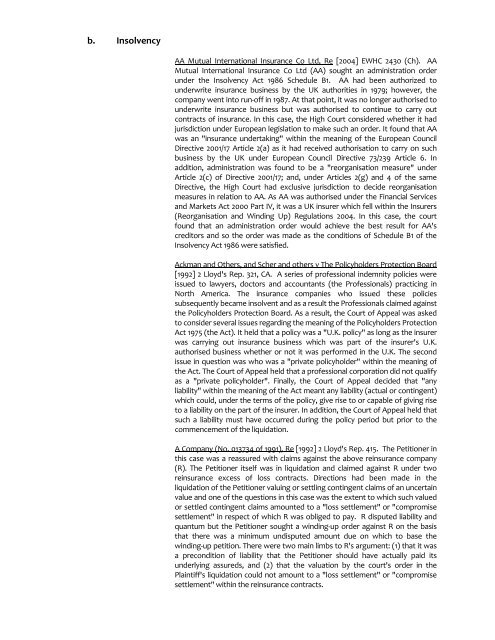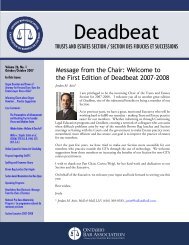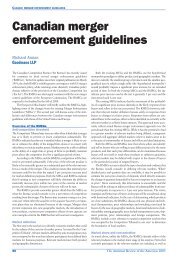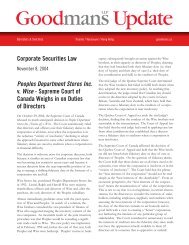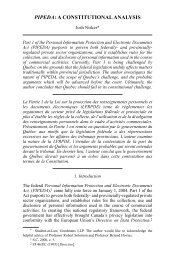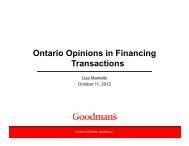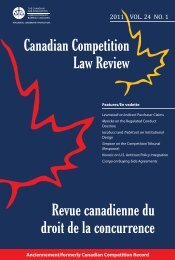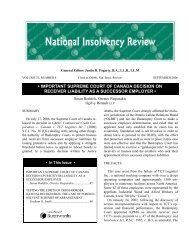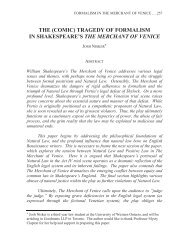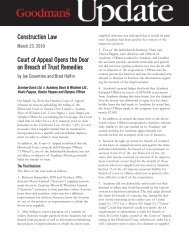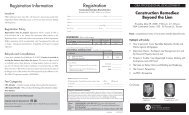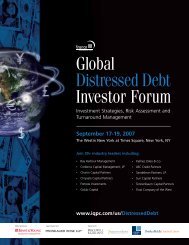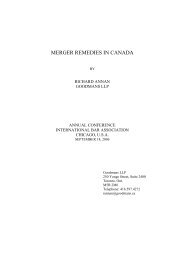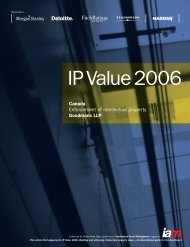- Page 1 and 2:
REFERENCE HANDBOOK ON INSURANCE COM
- Page 3 and 4:
Contributing Editors Cross‐Border
- Page 5 and 6:
Formal Proceedings ‐ Constitution
- Page 7 and 8:
Priorities ‐ Interstate Claimants
- Page 9 and 10:
Part III PART IV APPENDIX D. Bermud
- Page 172 and 173:
Rhode Island Statutes TITLE 27 Insu
- Page 174 and 175:
(17) "Policyholder" means an insure
- Page 176 and 177:
(3) All creditors, assumption polic
- Page 178 and 179:
(2) If, at any time, the conditions
- Page 180 and 181:
Run‐Off New York Seaton Ins. Co.
- Page 182 and 183:
as writs of seizure, were necessary
- Page 184 and 185:
Igel v. Phillips, 183 A.D. 220, 169
- Page 186 and 187:
wind up its affairs, even if the no
- Page 188 and 189:
insolvency, including the issue of
- Page 190 and 191:
over action would: (i) defeat domic
- Page 192 and 193:
the Commissioner of Insurance on be
- Page 194 and 195:
Sixth Circuit AmSouth Bank v. Dale,
- Page 196 and 197:
action did not automatically preclu
- Page 198 and 199:
proceedings. The New York insurance
- Page 200 and 201:
independent receivership proceeding
- Page 202 and 203:
Connecticut Florida Grasso v. City
- Page 204 and 205:
instance, because the regulation of
- Page 206 and 207:
company filed a motion for declarat
- Page 208 and 209:
Commissioner of Ins. v. Mid‐Ameri
- Page 210 and 211:
district court had exclusive jurisd
- Page 212 and 213:
SEC v. Republic National Life Ins.
- Page 214 and 215:
legislature granted exclusive juris
- Page 216 and 217:
Rejecting the liquidator's motion,
- Page 218 and 219:
time as an administrative claim had
- Page 220 and 221:
mandate application of Florida's in
- Page 222 and 223:
This simple declarative sentence pr
- Page 224 and 225:
its earlier holding [Bonura v. Unit
- Page 226 and 227:
In re Application for an Order Stay
- Page 228 and 229:
to prosecution of claims against hi
- Page 230 and 231:
were closely intertwined, the entir
- Page 232 and 233:
South Carolina Texas New South Life
- Page 234 and 235:
the insurance code. The trial court
- Page 236 and 237:
within the meaning of the insurance
- Page 238 and 239:
was overbroad in delaying indefinit
- Page 240 and 241:
financial institutions to transfer
- Page 242 and 243:
entities were in fact a "single bus
- Page 244 and 245:
the company in that other state to
- Page 246 and 247:
easoning that: 1) its earlier findi
- Page 248 and 249:
McConnell v. All‐Coverage Insuran
- Page 250 and 251:
company. The court also found that
- Page 252 and 253:
impermissible because they were not
- Page 254 and 255:
contrary appellate court judgment,
- Page 256 and 257:
exhaust the pro rata shares of solv
- Page 258 and 259:
asserted a priority despite the fac
- Page 260 and 261:
The question presented was whether
- Page 262 and 263:
Cir. 2000). The Ninth Circuit adopt
- Page 264 and 265:
entity with those conferred or with
- Page 266 and 267:
Pennsylvania court had exclusive ju
- Page 268 and 269:
liquidator argued that Ohio’s sta
- Page 270 and 271:
Vermont Costle v. Fremont Indemnity
- Page 272 and 273:
(“Munich”) and NAC Reinsurance
- Page 274 and 275:
Pine Top Ins. Co. v. Continental Re
- Page 276 and 277:
incapable of being performed," foun
- Page 278:
completion of the plan of arbitrati
- Page 281 and 282:
the policy make specific provision
- Page 283 and 284:
the catastrophe policy prevents “
- Page 285 and 286:
sought only money damages. 3 Hence,
- Page 287 and 288:
Commissioner has reasonable grounds
- Page 289 and 290:
policyholders were brought against
- Page 291 and 292:
a supervision‐release order for a
- Page 293 and 294:
secure a court‐ordered receiversh
- Page 295 and 296:
no liability exists for any acts ta
- Page 297 and 298:
stay of any proceeding in which an
- Page 299 and 300:
Fields v. Fidelity General Ins. Co.
- Page 301 and 302:
Illinois insurance code is vested i
- Page 303 and 304:
Michigan Daniel v. Citizens' Mutual
- Page 305 and 306:
appointment of a receiver to wind u
- Page 307 and 308:
independent actuarial firm, and all
- Page 309 and 310:
owned by one corporation, proposed
- Page 311 and 312:
den'd, 126 N.J. 389 (1991). The cou
- Page 313 and 314:
constitutional the statute under wh
- Page 315 and 316:
The circuit judge's denial of plain
- Page 317 and 318:
duplication provision of the PPCIGA
- Page 319 and 320:
New York National Union Fire Ins. C
- Page 321 and 322:
insurance companies pursuant to sta
- Page 323 and 324:
Matter of Morgan, 277 N.Y. 203, 14
- Page 325 and 326:
Alabama Arizona California Moody v.
- Page 327 and 328:
Schenek v. Citizens Casualty Co., 6
- Page 329 and 330:
disclosed in its annual statement.
- Page 331 and 332:
insurance company, the court held t
- Page 333 and 334:
Pennsylvania's interest in investig
- Page 335 and 336:
Pennsylvania Commonwealth ex rel. C
- Page 337 and 338:
non‐mandatory preference for the
- Page 339 and 340:
Powers and Duties of the Rehabilita
- Page 341 and 342:
the insolvency clause of a reinsura
- Page 343 and 344:
Financial Indemnity Company v. Supe
- Page 345 and 346:
ecause they had constructive notice
- Page 347 and 348:
Illinois law does not provide the D
- Page 349 and 350:
claimed. Although the code allows t
- Page 351 and 352:
040(3)(a) or 304‐33.190(2). Rathe
- Page 353 and 354:
to the state's unemployment compens
- Page 355 and 356:
State ex rel. ISC Financial Corp. v
- Page 357 and 358:
authorizing the Liquidator to prope
- Page 359 and 360:
implement the statutory liquidation
- Page 361 and 362:
that trust claimants will recover a
- Page 363 and 364:
showing that the rehabilitator’s
- Page 365 and 366:
insurer, sued former owner of insur
- Page 367 and 368:
Brainard v. Foster, Civil Action No
- Page 369 and 370:
Flowers v. Tennessee Trucking Ass
- Page 371 and 372:
the insurer under Texas law; and th
- Page 373 and 374:
state court against B.C. Rogers, an
- Page 375 and 376:
People ex rel. Baylor v. Multi‐St
- Page 377 and 378:
equiring the insurer to produce doc
- Page 379 and 380:
failed to demonstrate to the contra
- Page 381 and 382:
intervention. It is not an abuse of
- Page 383 and 384:
eview the actions of the insurance
- Page 385 and 386:
not reported losses (IBNR). The Sup
- Page 387 and 388:
Commonwealth tort claims against th
- Page 389 and 390:
Liquidation Act. On a petition for
- Page 391 and 392:
defendant to bring the action to th
- Page 393 and 394:
Main Ins. Co. v. Bradford, Williams
- Page 395 and 396:
proceedings against an insolvent Ne
- Page 397 and 398:
Matter of Title, Etc., Co. of Buffa
- Page 399 and 400:
the R.C. 3955.19 stay provision as
- Page 401 and 402:
Casualty Insurance Guaranty Associa
- Page 403 and 404:
property without a hearing. The Cou
- Page 405 and 406:
consent of the liquidators, the bro
- Page 407 and 408:
ecording of an order of liquidation
- Page 409 and 410:
Florida Imagine Ins. Co. v. State o
- Page 411 and 412:
executory contracts, and the insure
- Page 413 and 414:
procured new policies in a solvent
- Page 415 and 416:
Safeway liable for the entire amoun
- Page 417 and 418:
even lower interest rate than that
- Page 419 and 420:
North Carolina Texas North Carolina
- Page 421 and 422:
an individual and official capacity
- Page 423 and 424:
enterprise with United States Gener
- Page 425 and 426:
were not ultra vires acts. There we
- Page 427 and 428:
authorized by state law to petition
- Page 429 and 430:
Stamp v. Touche Ross & Co., 263 Ill
- Page 431 and 432:
control, or possession of the insur
- Page 433 and 434:
offers to compromise because severa
- Page 435 and 436:
insolvent insurer brought an action
- Page 437 and 438:
"interested parties" in a proceedin
- Page 439 and 440:
Assets of the Insolvent Insurer's E
- Page 441 and 442:
Garamendi v. SDI Vendome, No. CV 02
- Page 443 and 444:
for personal injury claim brought a
- Page 445 and 446:
transacting any insurance business
- Page 447 and 448:
Bent v. Hart, 10 Mo. App. 143 (1881
- Page 449 and 450:
discretion allowed policyholders to
- Page 451 and 452:
In re New State Life Ins. Co., 23 P
- Page 453 and 454:
ecover a subscription fund executed
- Page 455 and 456:
Pursuant to D.C. Code Ann. § 35‐
- Page 457 and 458:
ecause all the directors of the dis
- Page 459 and 460:
agree on whether Kentucky statutory
- Page 461 and 462:
W. J. Jones & Son v. Independence I
- Page 463 and 464:
precluding liquidator's avoidance o
- Page 465 and 466:
association's directors for monies
- Page 467 and 468:
a Transit insured. Fifteen months l
- Page 469 and 470:
court granted the motion. On appeal
- Page 471 and 472:
unearned portion of the premium was
- Page 473 and 474:
the insolvent Mission Insurance Com
- Page 475 and 476:
Drake v. Rollo, 7 Fed. Cas. Pg. 105
- Page 477 and 478:
judge to act as presiding judge ove
- Page 479 and 480:
$25,000 compromise would be paid to
- Page 481 and 482:
express purpose is to avoid financi
- Page 483 and 484:
einsurance contract against moneys
- Page 485 and 486:
provision and therefore its ruling
- Page 487 and 488:
complaint, the defendants would not
- Page 489 and 490:
as an offset against the insolvent
- Page 491 and 492:
Swiss Re made payments to Protectiv
- Page 493 and 494:
directors were not included in that
- Page 495 and 496:
purported rescission by the company
- Page 497 and 498:
members. The court further held tha
- Page 499 and 500:
instituting of the receivership pro
- Page 501 and 502:
would prevent a multiplicity of act
- Page 503 and 504:
assessments against members of a do
- Page 505 and 506:
Richards v. Hale, 14 O.C.D. 468, 1
- Page 507 and 508:
Wetmore v. Scalf, 85 S.C. 285, 67 S
- Page 509 and 510:
mutual insurance company because Wi
- Page 511 and 512:
out liquidation assessment powers i
- Page 513 and 514:
their insurer became insolvent. Any
- Page 515 and 516:
insolvent carrier, sought to interp
- Page 517 and 518:
The Home Insurance Co. v. Hooper, 2
- Page 519 and 520:
coverage. The court held that cover
- Page 521 and 522:
insurance, and that Mission was not
- Page 523 and 524:
contract. Further, as the parties t
- Page 525 and 526:
agreement. The Colorado receiver cl
- Page 527 and 528:
preliquidation assets that could be
- Page 529 and 530:
agreements with Legion Insurance Co
- Page 531 and 532:
prediction, and was neither arbitra
- Page 533 and 534:
Guaranty Association (“PPCIGA”)
- Page 535 and 536:
contrary holding would permit these
- Page 537 and 538:
People ex rel. Bolton v. Progressiv
- Page 539 and 540:
where the solvency of the company,
- Page 541 and 542:
agent of all premiums collected by
- Page 543 and 544:
subsequent to institution of delinq
- Page 545 and 546:
corporate mismanagement and account
- Page 547 and 548:
Mendel v. Garner, 283 Ark. 473, 678
- Page 549 and 550:
The lower court denied the claim be
- Page 551 and 552:
definition, a “covered claim,”
- Page 553 and 554:
Missouri MSEJ, LLC, v. Transit Cas.
- Page 555 and 556:
medical malpractice action, which i
- Page 557 and 558:
Suit was transferred to the court o
- Page 559 and 560:
within policy limits. The insolvent
- Page 561 and 562:
alleged negligence of an insured of
- Page 563 and 564:
Arkansas Colorado Florida Baldwin
- Page 565 and 566:
liquidator was entitled to rely upo
- Page 567 and 568:
Ohio Covington v. Ind. Dep’t of N
- Page 569 and 570:
River abstention doctrines did not
- Page 571 and 572:
directly against manufacturer. The
- Page 573 and 574:
insurance commissioner entered into
- Page 575 and 576:
un ten months and twenty‐six days
- Page 577 and 578:
policies were delivered, the state
- Page 579 and 580:
Accordingly, the manufacturer sough
- Page 581 and 582:
Sizemore v. United Physicians Ins.
- Page 583 and 584:
insolvency. The court found for pla
- Page 585 and 586:
equires all claims against the rece
- Page 587 and 588:
cancelled by order of the court, th
- Page 589 and 590:
Dewey v. Davis, 82 Wis. 500, N.W. 7
- Page 591 and 592:
April 18, the filing of the Missour
- Page 593 and 594:
Texas Buckner v. Lloyd's Ins. Co. o
- Page 595 and 596:
payment by the California Insurance
- Page 597 and 598:
the tortfeasors to recover its paym
- Page 599 and 600:
Ga. App. 660, 440 S.E.2d 254 (1994)
- Page 601 and 602:
Act. The Court also noted that whet
- Page 603 and 604:
opportunity to settle.” The court
- Page 605 and 606:
jurisdictions that did find associa
- Page 607 and 608:
Ohio Lake Hospital System, Inc. v.
- Page 609 and 610:
award. It became insolvent, however
- Page 611 and 612:
Rhulen advanced claim payments to T
- Page 613 and 614:
entitled to coverage from the Illin
- Page 615 and 616:
the negligence claim, brought by th
- Page 617 and 618:
insurer did not thereby release fro
- Page 619 and 620:
when contingent claims must necessa
- Page 621 and 622:
In Matter of Liquidation Of Integri
- Page 623 and 624:
from the time damages are certain o
- Page 625 and 626:
In re N.Y. Surety Co., 723 N.Y.S.2d
- Page 627 and 628:
Governmental/Superpriority Claims S
- Page 629 and 630:
Reliance Ins. Co. v. Shriver, Inc.,
- Page 631 and 632:
Georgia Boyd v. Wright, 148 Ga. 216
- Page 633 and 634:
policyholders, judgment creditors o
- Page 635 and 636:
when it appears that such funds or
- Page 637 and 638:
within the insurance statutes. Cred
- Page 639 and 640:
Priorities ‐ Federal U.S. Supreme
- Page 641 and 642:
statute was preempted by the federa
- Page 643 and 644:
instituting or taking further actio
- Page 645 and 646:
Florida Dilme v. SBP Serv., Inc. an
- Page 647 and 648:
Massachusetts Commissioner of Insur
- Page 649 and 650:
New York Finkelstein v. Van Schaick
- Page 651 and 652:
Texas Op. Att'y. Gen. WW‐795 (Tex
- Page 653 and 654:
Illinois People ex rel. Potts v. Co
- Page 655 and 656:
Arizona Colorado State ex rel. Low
- Page 657 and 658:
equirements had not been complied w
- Page 659 and 660:
Michigan Commissioner of Insurance
- Page 661 and 662:
commissioner certain securities for
- Page 663 and 664:
State ex rel. Cincinnati Life Assn'
- Page 665 and 666:
and without assets in trust in Flor
- Page 667 and 668:
State ex rel. Burgess v. Crabbe, 11
- Page 669 and 670:
jurisdiction over the attorneys in
- Page 671 and 672:
Pennsylvania Lewycka v. Springfield
- Page 673 and 674:
meaning, held that the Indiana clai
- Page 675 and 676:
Rose v. Fid. Mut'l Life Ins. Co., 2
- Page 677 and 678:
uniform law or that it was necessar
- Page 679 and 680:
of incorporation of a mutual insure
- Page 681 and 682:
jurisdiction over that litigation f
- Page 683 and 684:
ehabilitation in Indiana and had ob
- Page 685 and 686:
Krueger v. Tabor, 546 So.2d 1317 (L
- Page 687 and 688:
and, because of the guarantees, for
- Page 689 and 690: Rhode Island injunction by arguing
- Page 691 and 692: In prior proceedings in this case,
- Page 693 and 694: state law issues and was contingent
- Page 695 and 696: Bryant v. Shields, Britton & Fraser
- Page 697 and 698: against the Wisconsin Insurance Sec
- Page 699 and 700: PART II Cross‐Border Run‐Offs a
- Page 701 and 702: CASE(S) Highland Insurance Company
- Page 703 and 704: CASE(S) Hatteras Reinsurance Ltd NR
- Page 705 and 706: • The Court in which the Chapter
- Page 707 and 708: As previously noted, of the sevente
- Page 709 and 710: WFUM Pool Solvent Schemes ~ In re G
- Page 711 and 712: arrangement, including solvent run
- Page 713 and 714: 5. Chapter 15 ~ Official Text 1501.
- Page 715 and 716: (d) §1502. Definitions. (2) an ind
- Page 717 and 718: (c) (d) A request for comity or coo
- Page 719 and 720: (a) (b) If the decision or certific
- Page 721 and 722: §1521. Relief that may be granted
- Page 723 and 724: (4) approval or implementation of a
- Page 725 and 726: B. United Kingdom ‐‐ The Positi
- Page 727 and 728: 1. majority votes in favour of the
- Page 729 and 730: eported claims, was not of great im
- Page 731 and 732: and Jersey. The English schemes wou
- Page 733 and 734: Life Assurance Limited (FPLLA) both
- Page 735 and 736: MB Group Plc, Re (1989) 5 B.C.C. 68
- Page 737 and 738: issued a third circular which state
- Page 739: court had jurisdiction to sanction
- Page 743 and 744: the agreement would not be avoided
- Page 745 and 746: submitted that cover had been provi
- Page 747 and 748: liquidators and in the English bank
- Page 749 and 750: court did not strike out the petiti
- Page 751 and 752: Stein so that he could pursue it. B
- Page 753 and 754: Part III of the Winding‐up and Re
- Page 755 and 756: v. Proceedings in Canada to Assist
- Page 757 and 758: D. Bermuda ‐‐ The Bermuda Persp
- Page 759: Hong Kong Court to restructure the
- Page 791 and 792:
Excluded Lines - Ocean Marine Louis
- Page 793 and 794:
Covered Claim - Unearned Premium co
- Page 795 and 796:
Oregon Corvallis Aero Service, Inc.
- Page 797 and 798:
purposes of joint and several liabi
- Page 799 and 800:
Affiliated FM Ins. Co. v. State, 33
- Page 801 and 802:
Heninger v. Riley, 317 Pa. Super. 5
- Page 803 and 804:
assumed the obligations of Dr. Lucc
- Page 805 and 806:
Florida Hawaii Fernandez v. Florida
- Page 859 and 860:
Case Law Digest Supplement LIFE & H
- Page 861 and 862:
Texas Messagephone, Inc., et al v.
- Page 863 and 864:
were invested in four group annuity
- Page 865 and 866:
Alaska Arizona Illinois Unisys Corp
- Page 867 and 868:
Minnesota Honeywell, Inc. v. Minnes
- Page 869 and 870:
plan participants rather than the G
- Page 871 and 872:
esponsible for attorneys’ fees an
- Page 873 and 874:
Alaska Arizona Indiana Unisys Corp.
- Page 875 and 876:
Federal Jurisdiction - Preemption c
- Page 877 and 878:
Supreme Court California New York U
- Page 879 and 880:
Assessments Assessments - In Genera
- Page 881 and 882:
the sales transaction is not uncons
- Page 883 and 884:
State Department of Insurance Insur
- Page 885 and 886:
Kentucky State Department of Insura
- Page 887 and 888:
New Jersey New Mexico State Departm
- Page 889 and 890:
Virginia Washington State Departmen
- Page 891 and 892:
© 2009 National Association of Ins
- Page 893 and 894:
CO Marcy Morrison Commissioner (Wes
- Page 895 and 896:
KS Sandy Praeger Commissioner NAIC
- Page 897 and 898:
NH Roger A. Sevigny Commissioner NA
- Page 899 and 900:
TN Leslie A. Newman Commissioner (V
- Page 901 and 902:
NAIC OFFICES NAIC Central Office: 2
- Page 903 and 904:
GUARANTY FUND DIRECTORY Updated 02/
- Page 905 and 906:
GUARANTY FUND DIRECTORY Updated 02/
- Page 907 and 908:
GUARANTY FUND DIRECTORY Updated 02/
- Page 909 and 910:
GUARANTY FUND DIRECTORY Updated 02/
- Page 911 and 912:
GUARANTY FUND DIRECTORY Updated 02/
- Page 913 and 914:
GUARANTY FUND DIRECTORY Updated 02/
- Page 915 and 916:
GUARANTY FUND DIRECTORY Updated 02/
- Page 917 and 918:
GUARANTY FUND DIRECTORY Updated 02/
- Page 919 and 920:
GUARANTY FUND DIRECTORY Updated 02/
- Page 921 and 922:
nolhga.com :: state ga contact info
- Page 923 and 924:
nolhga.com :: state ga contact info
- Page 925 and 926:
nolhga.com :: state ga contact info
- Page 927 and 928:
nolhga.com :: state ga contact info


